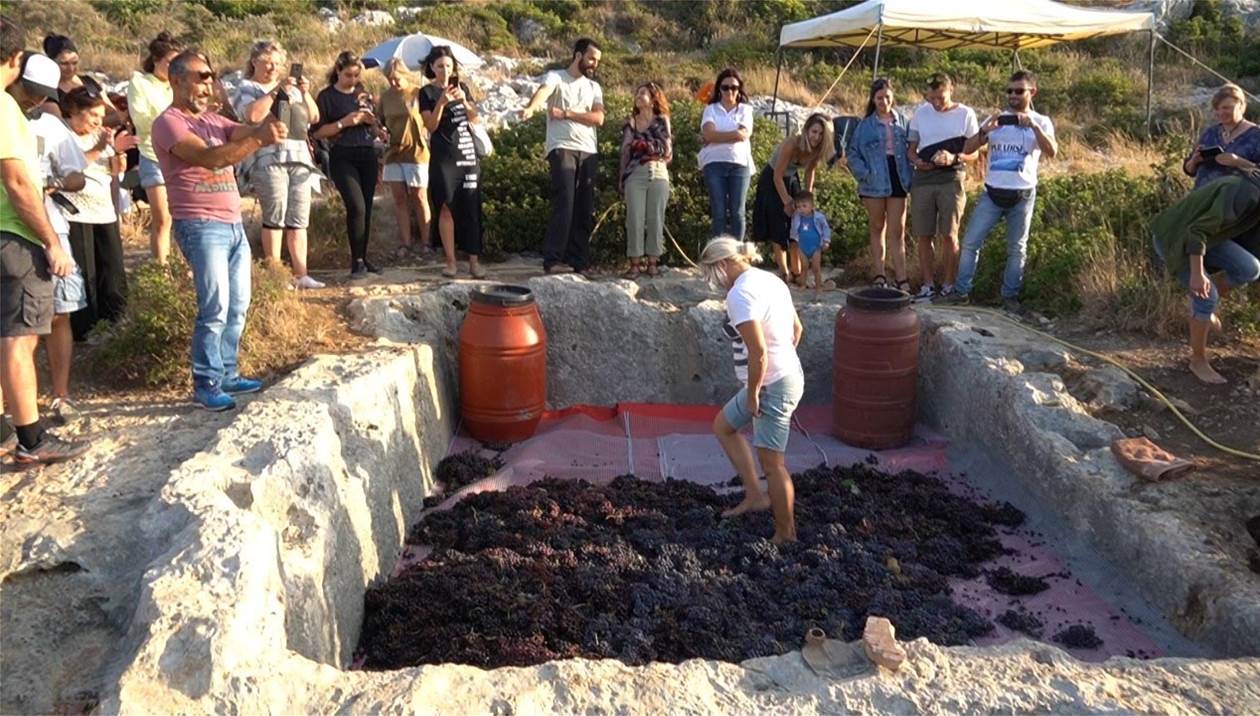Crete, the largest of the Greek islands, is renowned for its rich history, diverse landscapes, and vibrant culture. Among its many traditions, winemaking stands out as a particularly cherished practice, deeply rooted in the island’s heritage. The ritual of grape-stomping, a crucial step in traditional winemaking, offers a fascinating glimpse into Crete’s past and its enduring connection to viticulture. This text explores the history, significance, and contemporary relevance of grape-stomping rituals in Cretan winemaking, celebrating their role in producing some of the island’s finest wines.
The Historical Roots of Cretan Winemaking
Winemaking in Crete dates back over 4,000 years, with evidence of viticulture found in the ancient Minoan civilization (circa 2600 to 1100 BC). Archaeological discoveries, such as wine presses and storage vessels, indicate that wine played a significant role in Minoan society, both as a commodity and a ceremonial offering.
Throughout the centuries, Cretan winemaking evolved, influenced by various cultures, including the Greeks, Romans, Byzantines, Venetians, and Ottomans. Each period contributed to the refinement of winemaking techniques and the expansion of vineyards across the island. Despite these influences, the essence of traditional Cretan winemaking has remained intact, characterized by its use of indigenous grape varieties and time-honored methods.
The Grape-Stomping Ritual
Grape-stomping, also known as “pigeage” in French winemaking, is one of the oldest and most traditional methods of crushing grapes to extract their juice. This process involves treading the grapes with bare feet, a practice that has been passed down through generations in Crete. Grape-stomping is not only a practical technique but also a cultural ritual that embodies the communal and celebratory aspects of winemaking.
1. The Harvest: The grape-stomping ritual begins with the grape harvest, known as “trigos” in Greek. This takes place in late summer or early autumn, depending on the grape variety and local climate. Families and communities come together to handpick the grapes, selecting the best clusters for winemaking. The harvest itself is a festive event, often accompanied by singing, dancing, and feasting.
2. Preparing the Grapes: Once harvested, the grapes are transported to the wine press, known as the “lenos” in Greek. The lenos is a shallow, stone or wooden basin with a slight incline, designed to collect the grape juice as it is extracted. The grapes are spread evenly across the floor of the lenos, ready for stomping.
3. The Stomping Process: Participants, usually family members or friends, enter the lenos barefoot and begin to tread the grapes. The rhythmic motion of stomping breaks the grape skins, releasing their juice while leaving the seeds and stems largely intact. This gentle crushing method helps preserve the integrity of the grapes, contributing to the quality and flavor of the wine.
4. Community and Celebration: Grape-stomping is a communal activity, often accompanied by music, dancing, and laughter. It is a time of celebration, bringing people together to share in the joy of the harvest and the anticipation of the wine to come. The ritual strengthens social bonds and fosters a sense of collective achievement.
5. Fermentation and Aging: After the stomping, the grape juice, known as “must,” is collected and transferred to fermentation vessels. Traditionally, these were large clay jars called “pithoi,” but today stainless steel or wooden barrels are also used. The must undergoes fermentation, converting the sugars into alcohol and transforming the juice into wine. The wine is then aged for several months to years, developing its flavor and complexity.
Cultural Significance and Contemporary Relevance
The grape-stomping ritual holds deep cultural significance in Crete, symbolizing the island’s rich viticultural heritage and the importance of community and tradition.
1. Preservation of Tradition: Grape-stomping is a tangible link to Crete’s past, preserving ancient techniques and cultural practices. By continuing this ritual, Cretans honor their ancestors and maintain a connection to their history and heritage.
2. Celebrating Community: The communal nature of grape-stomping reinforces social cohesion and fosters a sense of belonging. It is an opportunity for families and communities to come together, celebrate their collective efforts, and share the fruits of their labor.
3. Sustainable Practices: Traditional winemaking methods, including grape-stomping, align with sustainable and organic practices. By avoiding the use of mechanical crushers and modern additives, these methods promote natural fermentation and minimal intervention, resulting in wines that reflect the true character of the grapes and the terroir.
4. Tourist Attraction: In recent years, grape-stomping has become a popular attraction for tourists seeking authentic cultural experiences. Many vineyards and wineries in Crete offer visitors the chance to participate in grape-stomping events, providing a unique and immersive insight into the island’s winemaking traditions.
5. Artistic Expression: The ritual of grape-stomping has also inspired artistic expression, featuring prominently in Cretan folklore, music, and dance. It is celebrated in local festivals and depicted in art, highlighting its enduring cultural resonance.
Conclusion
The grape-stomping rituals of Crete are a vibrant and enduring aspect of the island’s winemaking heritage. This ancient practice, passed down through generations, embodies the communal spirit, cultural significance, and sustainable values of traditional Cretan viticulture. By preserving and celebrating these rituals, Cretans honor their history, foster social bonds, and produce wines that capture the essence of their land and traditions. For visitors and locals alike, participating in or witnessing a grape-stomping event offers a unique and enriching experience, connecting them to the timeless rhythms of Cretan life and the enduring art of winemaking.


